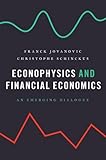Econophysics and financial economics : An emerging dialogue / Franck Jovanovic and Christophe Schinckus.
Publisher: New York City : Oxford University Press, 2017Description: xiv, 230 pages ; 25 cmContent type:- text
- unmediated
- volume
- 9780190205034 (hardback)
- 332.015195 JOV 23
- HG106 .J683 2017
- BUS069030 | SCI055000
| Item type | Current library | Collection | Shelving location | Call number | Status | Date due | Barcode |
|---|---|---|---|---|---|---|---|
 BOOKs
BOOKs
|
National Law School | Reference | MPP Section | 332.015195 JOV (Browse shelf(Opens below)) | Available | 36606 |
Browsing National Law School shelves, Shelving location: MPP Section, Collection: Reference Close shelf browser (Hides shelf browser)

|

|

|

|

|

|

|
||
| 330.9 BER Morality and power : | 331.137042 GRE Technology and the future of work : | 331.62 BOR Foundations of migration economics / | 332.015195 JOV Econophysics and financial economics : | 332.71 JOS Factors affecting financial inclusion in rural areas : | 333.91 CON Handbook of energy politics / | 334.0917 HOD The logic of public-private partnerships : |
Includes bibliographical references (pages 185-216) and index.
Contents: Foundations of financial economics: the key role of the Gaussian distribution --
Extreme values in financial economics: from their observation to their integration into the Gaussian framework --
New tools for extreme-value analysis: statistical physics goes beyond its borders --
The disciplinary position of Econophysics: new opportunities for financial innovations --
Major contributions of econophysics to financial economics --
Towards a common framework --
Conclusion: What kind of future lies in store for econophysics?
" Econophysics and Financial Economics provides the first extensive analytic comparison between models and results from econophysics and financial economics in an accessible and common vocabulary. Jovanovic and Schinckus move beyond disciplinary frontiers to initiate the development of a common theoretical framework that makes sense for both traditionally trained financial economists and econophysicists. The major issues that limit and obstruct collaboration between the two fields are analyzed in detail. The book explains the theoretical and methodological foundations of these two fields in an accessible vocabulary providing the first extensive analytic comparison between models and results from both fields. By mixing conceptual, historical, theoretical and formal arguments and analysis, the book details the recent results in econophysics that bring it closer to financial economics. Beyond the clarifying the current situation of two camps, this book also proposes a generic model compatible with the two fields that in turn helps define minimal conditions for common models. It also identifies what remains to be done for econophysicists to contribute significantly to financial economics. Finally, this book provides a research agenda for a more fruitful collaboration between econophysicists and financial economists, creating new research opportunities. Econophysics and Financial Economics is an important step in creating a profitable dialogue between financial economists and econophysicists. It does so by identifying a common theoretical framework allowing the creation of more efficient models for the financial industry. "-- Provided by publisher.
"This book moves beyond the disciplinary frontiers in order to initiate the development of a common theoretical framework that makes sense for both traditionally trained financial economists and econophysicists. Unlike other publications dedicated to econophysics, this book is written by two financial economists and it situates econophysics in the evolution of financial economics. The major issues that concern the collaboration between the two fields are analyzed in detail. More specifically, this book explains the theoretical and methodological foundations of these two fields in an accessible vocabulary providing the first extensive analytic comparison between models and results from both fields. The book also identifies the major conceptual gate-keepers that complicate dialogue between the two communities while it provides elements to overcome them. By mixing conceptual, historical, theoretical and formal arguments our analysis bridges the current deaf dialogue between financial economists and econophysicists. This book details the recent results in econophysics that bring it closer to financial economics. So doing, it identifies what remains to be done for econophysicists to contribute significantly to financial economics. Beyond the clarification of the current situation, this book also proposes a generic model compatible with the two fields, defining minimal conditions for common models. Finally, this book provides a research agenda for a more fruitful collaboration between econophysicists and financial economists, creating new research opportunities. In this perspective, it lays the foundations for common theoretical framework and models"-- Provided by publisher.

There are no comments on this title.